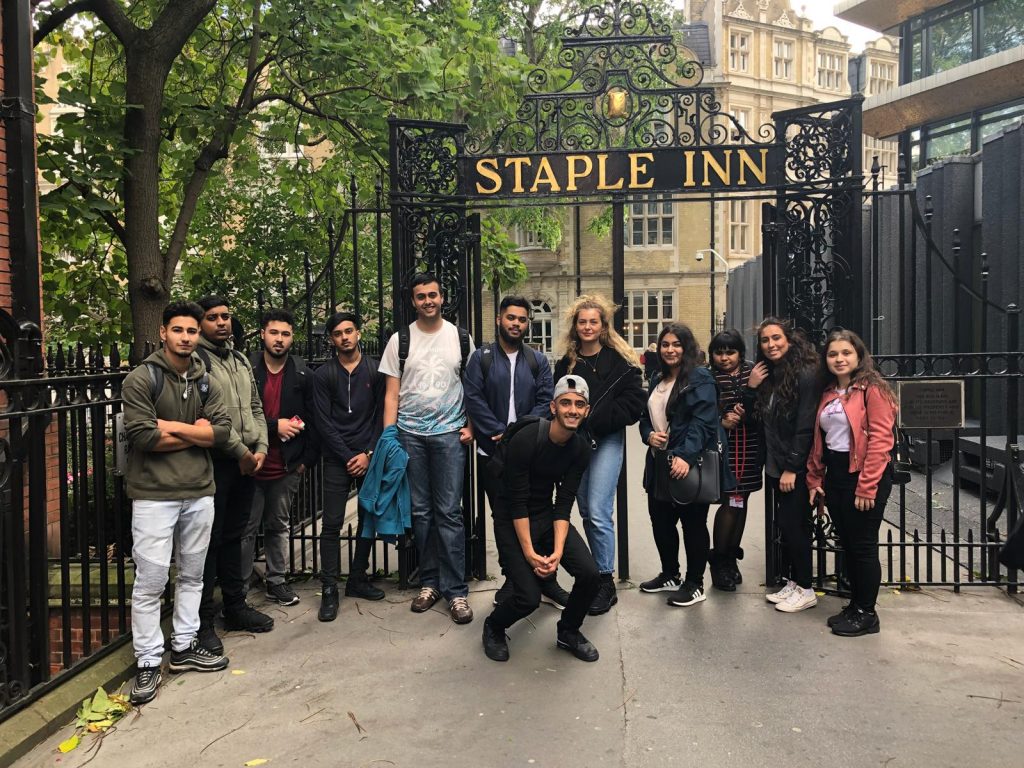Legal London: Paintings, Monks and Wool… (Exploring the Law)
In the induction period, new LLB students at the City Law School were asked to undertake the ‘Exploring the Law’ activity – wandering round the local area to find certain buildings, statues, streets or murals on one of eight trails around legal London (compiled by Emily Allbon), along with their tutor group. They then penned a short blog on some aspect of their travels. 21 students were chosen as winners and these will be posted here on Lawbore Future Lawyer. This excellent piece was chosen as one of the 21 (joint second place) – well done to Aymane Hamidi.
It’s interesting how short sighted you can become when you’ve lived somewhere your entire life. We tend to focus solely upon the things that affect us on a day to day basis, rarely digging deeper into the rich and vibrant history which surrounds us. This is particularly true for me as a Londoner; in all the time I have been here, never have I thought to explore the city I call my home; it was only once tasked with investigating the legal history of London that I began to unravel the fascinating tapestry I had ignored for many years.

Armed with nothing but our wits and more importantly, Google Maps, we headed out in our respective groups to search for legal landmarks in London. The first stop on this law tour was the Museum of The Order of St John, a gallery of historical artefacts. This confused me; how can a museum be in anyway related to the law? It was only once I did some research that I learned the museum was home to a fairly famous Caravaggio painting (The Cardsharps), which was the subject of a legal battle a few years ago. I’ll be honest, I have little to no interest in art. Don’t get me wrong, I’ve tried on many occasions to culture myself but unfortunately, to no avail. I just don’t get it. However, this did provide me with an opportunity to get an insight into the course I’ll be studying over the next three years and it most certainly did not disappoint.
The previous owner of The Cardsharps sold the painting for £46,000 when told by experts that it was not a genuine Caravaggio. It was later revealed the painting was in fact genuine with a real value of £10 million. No, that’s not a typo. £10 million. Understandably frustrated (to say the least), the previous owner filed a negligence suit against the experts who severely undervalued the painting. However, just to add insult to injury, this claim lost and resulted in the previous owner having to shell out a further £1.8 million to the experts he had attempted to sue, excluding legal and court fees. I never would’ve thought I would be remotely interested in art but reading about the legal battle both taught me more about how interconnected London landmarks are with the law and fuelled my hunger to begin my legal education.
Our journey continued and took us to a monks’ crypt in Magpie Alley and a church with a bloody history. Whilst they’re both fascinating sources of little-known London history, I was far more intrigued by the final location of our London law landmark tour, Staples Inn. It may not sound as dramatic as a hidden crypt or a bloody church, but Staples Inn is as steeped in history as any other landmark. Its legal origins can be traced back to the year 1400 where it was used by the Inns of Court for education and training of barristers, even housing aspiring lawyers.

Even before this, the inn was used for storing wool for trade, conveying the significance of this location; not only was it a legal hub but it also symbolised the prestige held by London as a centre of trade, a legacy which has continued to modern day as seen through the fact that English contract law is internationally favoured during trade deals. Having survived the Great Fire of London in 1666 and extensive bombing during the Blitz, the Staple Inn now serves as a legal chambers. This landmark may seem unimpressive or even insignificant, but to me, it represents the stability of the legal profession and instils within me a sense of pride. I am proud to be entering the world of law, to attach my name to this historical vocation and to become a part of the captivating history surrounding it.
It’s funny to think that I’d walked past many of these places before, never glancing up or giving them a second thought, but once I began paying attention, my two-dimensional perception of London disappeared and my eyes were opened to this whole other world hidden just beneath the surface. Although my journey around London may be over, my journey into the law has only just begun.
